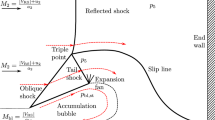Abstract
The scenario of detonative ignition in shocked mixture is significant because it is a contributor to deflagration to detonation transition, for example following shock reflections. However, even in one dimension, simulation of ignition between a contact surface or a flame and a shock moving into a combustible mixture is difficult because of the singular nature of the initial conditions. Initially, as the shock starts moving into reactive mixture, the region filled with reactive mixture has zero thickness. On a fixed grid, the number of grid points between the shock and the contact surface increases as the shock moves away from the latter. Due to initial lack of resolution in the region of interest, staircasing may occur, whereby the resulting plots consist of jumps between few values a few grid points, and these numerical artifacts are amplified by the chemistry which is very sensitive to temperature, leading to unreliable results. The formulation is transformed, replacing time and space by time and space over time as the independent variables. This frame of reference corresponds to the self-similar formulation in which the non-reactive problem remains stationary, and the initial conditions are well-resolved. Additionally, a solution obtained from short time perturbation is used as initial condition, at a time still short enough for the perturbation to be very accurate, but long enough so that there is sufficient resolution. The numerical solution to the transformed problem is obtained using an essentially non-oscillatory algorithm, which is adequate not only for the early part of the process, but also for the latter part, when chemistry leads to appearance of a shock and eventually a detonation wave is formed. A validation study was performed and the results were compared with the literature, for single step Arrhenius chemistry. The method and its implementation were found to be effective. Results are presented for values of activation energy ranging from mild to stiff.
Similar content being viewed by others
Abbreviations
- A :
-
Coefficient defined by (17)
- B :
-
Coefficient defined by (18)
- C :
-
Coefficient defined by (19)
- D :
-
Coefficient defined by (20)
- E :
-
Activation energy
- K :
-
Rate multiplier
- M :
-
Mach number
- Q :
-
Total heat release
- R :
-
Gas constant in the ideal gas equation of state
- T :
-
Temperature
- V :
-
Shock speed
- Z :
-
Reflection coefficient
- a :
-
Speed of sound
- e :
-
Internal energy
- p :
-
Pressure
- s :
-
Source = −exp (−E)
- t :
-
Time
- u :
-
Velocity
- x :
-
Longitudinal coordinate
- λ :
-
Mass fraction
- η :
-
= x/t
- γ :
-
Ratio of specific heats
- ρ :
-
Density
- σ :
-
Speed along a characteristic
- s :
-
Postshock state
- o :
-
Preshock state
- i :
-
Refers to characteristic i = 1, 2 and 3, respectively
References
Zel’dovich Y.B., Librovich V.B., Makhviladze G.M., Sivashinsky G.I.: On the development of detonation in a non-uniformly preheated gas. Astronaut. Acta 15, 313–321 (1970)
Blythe P.A., Crighton D.G.: Shock-generated ignition: the induction zone. Proc. R. Soc. Lond. A 426, 189–209 (1989)
Bauwens L.: Ignition between a shock and a contact surface: influence of the downstream temperature. Proc. Combust. Inst. 28, 653–661 (2000)
Bauwens L., Liang Z.: Shock formation ahead of hot spots. Proc. Combust. Inst. 29, 2795–2802 (2003)
Short M., Dold W.: Unsteady gasdynamic evolution of an induction domain between a contact surface and a shock wave. I: thermal runaway. SIAM J. Appl. Math. 56, 1295–1316 (1996)
Sharpe, G.J., Short, M. Ignition of thermally sensitive explosives between a contact surface and a shock. Phys. Fluids 19, 126102 (2007). doi:10.1063/1.2821909
Xu S.J., Aslam T., Aslam T., Aslam T.: High resolution numerical simulation of ideal and non-ideal compressible reacting flows with embedded internal boundaries. Combust. Theory Model. 1, 113–142 (1997)
Liang Z., Bauwens L.: Cell structure and stability of detonations with a pressure dependent chain-branching reaction rate model. Combust. Theory Model. 9(1), 93–112 (2005)
Bédard-Tremblay L., Melguizo-Gavilanes J., Bauwens L.: Detonation structure under chain-branching kinetics with small initiation rate. Proc. Combust. Inst. 32, 2339–2347 (2009)
Bédard-Tremblay L., Fang L., Melguizo-Gavilanes J., Bauwens L., Finstad P.H.E., Cheng Z., Tchouvelev A.V.: Simulation of detonation after an accidental hydrogen release in enclosed environments. Int. J. Hydrogen Energy 34(14), 5894–5901 (2009)
Bauwens L., Bauwens C.R.L., Wierzba I.: Oscillating flames: multiple scale analysis. Proc. R. Soc. Lond. A 465, 2089–2110 (2009)
Short M., Quirk J.J.: On the nonlinear stability and detonability limit of a detonation wave for a model three-step chain-branching reaction. J. Fluid Mech. 339, 89–119 (1997)
Author information
Authors and Affiliations
Corresponding author
Additional information
Communicated by S. Dorofeev.
This paper is based on work that was presented at the 22nd International Colloquium on the Dynamics of Explosions and Reactive Systems, Minsk, Belarus, July 27–31, 2009.
Rights and permissions
About this article
Cite this article
Melguizo-Gavilanes, J., Rezaeyan, N., Lopez-Aoyagi, M. et al. Simulation of shock-initiated ignition. Shock Waves 20, 467–478 (2010). https://doi.org/10.1007/s00193-010-0255-1
Received:
Revised:
Accepted:
Published:
Issue Date:
DOI: https://doi.org/10.1007/s00193-010-0255-1




